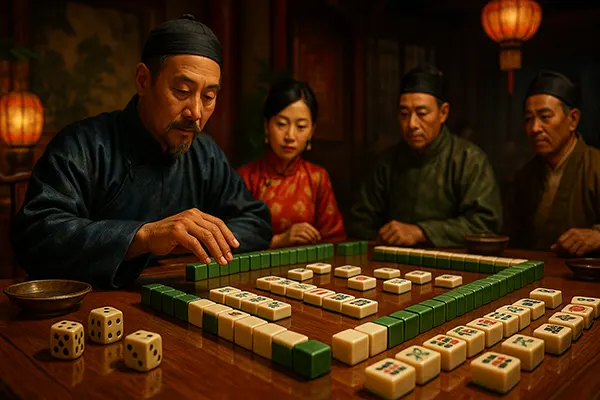Gambling has been an integral part of human culture for centuries, and few places have as rich a history of games of chance as ancient China. As one of the oldest civilizations known for practicing gambling, China’s gambling traditions reflect a blend of cultural significance and social rituals. This article delves into the fascinating evolution of Chinese gambling, tracing its journey from ancient dice games to the beloved game of Mahjong.
The Origins of Gambling in Ancient China
The history of gambling in China dates back thousands of years. One of the earliest forms of gambling involved the use of dice, which were often crafted from animal bones or other natural materials. These primitive dice games were not merely for entertainment; they were deeply intertwined with rituals and superstitions. Ancient Chinese texts hint at dice being used for divination and to predict fortunes, indicating their spiritual significance.
As gambling evolved, the games became more structured and competitive. During the Zhou Dynasty (1046–256 BCE), board games and dice games began to gain popularity among the aristocracy. Gambling during this period was often seen as a test of skill and intelligence, rather than purely as a game of luck. The symbolic meanings attached to dice also varied, as they were often linked to ancient Chinese beliefs about fate and destiny.
The introduction of playing cards during the Tang Dynasty (618–907 CE) marked a significant shift in Chinese gambling culture. Initially used for ceremonial purposes, cards soon became popular for gambling, adding a new dimension to social interactions and creating a foundation for later games, including Mahjong.
Dice Games to Mahjong: A Cultural Transformation
The transition from dice games to Mahjong highlights a cultural evolution. Mahjong, which emerged in the mid-19th century, borrowed elements from earlier dice and card games. It incorporated tiles that were conceptually similar to dice, bearing symbols and numbers that players needed to match or sequence. The strategic aspects of Mahjong also reflected the intellectual approach to games that had been prominent since ancient times.
Mahjong’s rapid rise to popularity can be attributed to its social appeal. Unlike solitary dice games, Mahjong brought people together, fostering social connections and camaraderie. Its widespread acceptance across different social strata made it a quintessential Chinese pastime, revered not just as a game, but as a cultural emblem.
Moreover, the game’s integration into celebrations and festivals underlines its importance. Mahjong became synonymous with family gatherings, symbolizing unity and shared joy. This cultural embrace cemented Mahjong’s status as a legacy game in Chinese society.
Gambling in Rituals and Cultural Practices
In ancient China, gambling was not merely recreational; it had ritualistic undertones. Many games were played during significant festivals and religious ceremonies, where the outcomes were believed to reflect the favor of deities. This connection between chance and divine will made gambling an essential element of spiritual life.
During the Lunar New Year, for instance, dice and card games were not only a means of entertainment but also a way to attract good fortune. The belief that luck could be summoned through gambling resonated deeply within traditional Chinese philosophy, where fortune and fate were considered dynamic and changeable.
Furthermore, gambling was sometimes employed as a method of decision-making or conflict resolution. Ancient texts reveal instances where disputes were settled through games of chance, emphasizing the deep-rooted cultural acceptance of gambling as a legitimate practice.
The Symbolism of Luck in Chinese Games
Chinese gambling games are imbued with symbols of luck and prosperity. The characters used in Mahjong, for example, represent wealth, longevity, and happiness. The act of drawing a winning tile is metaphorically linked to drawing good fortune into one’s life. Similarly, dice rolls were seen as signs from the heavens, indicating favorable or unfavorable outcomes.
Superstitions surrounding gambling have also endured through the centuries. Players often perform rituals before a game to enhance luck, such as tapping dice on specific surfaces or reciting auspicious phrases. These practices highlight the intertwining of belief and gameplay in Chinese tradition.
Even today, traditional gambling games are celebrated as part of China’s intangible cultural heritage. Mahjong tournaments and dice game reenactments serve as cultural preservation efforts, keeping ancient practices alive in a modern context.

Impact of Chinese Gambling on Asian Cultures
Chinese gambling traditions have had a profound influence on neighboring Asian cultures. Mahjong, in particular, spread to Japan, Korea, and Southeast Asia, where it adapted to local customs while retaining its Chinese roots. Variations of the game reflect regional preferences, demonstrating the adaptability of Chinese gambling concepts.
The practice of using dice for divination also traveled beyond China, influencing games and rituals in countries like Vietnam and Thailand. This cultural diffusion highlights the enduring appeal of Chinese games, both as leisure activities and as spiritual practices.
In modern Asia, Mahjong remains not only a game but a cultural phenomenon. Its presence in popular media, films, and literature underscores its importance as a symbol of social connection and cultural continuity.
Preservation of Gambling Heritage
Efforts to preserve ancient gambling traditions are ongoing. In China, cultural heritage organizations aim to document the history of games like Mahjong, ensuring that younger generations appreciate their cultural significance. Museums and exhibitions dedicated to ancient Chinese games serve as educational resources, showcasing the evolution of gambling over millennia.
These initiatives are crucial in safeguarding intangible cultural heritage, highlighting how gambling traditions have shaped social dynamics throughout Chinese history. Understanding the roots of Mahjong and dice games fosters a greater appreciation of their continued relevance in Chinese society.
As ancient practices blend with contemporary culture, Chinese gambling traditions persist as a bridge between the past and the present, offering insight into the historical evolution of games and their lasting impact.

